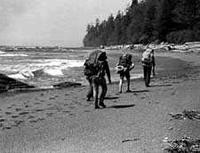Trails
TRAILS were the earliest land transportation routes in BC. Aboriginals used footpaths to travel within their traditional territories to hunting and FISHING sites and to communicate with other groups for purposes of trade and warfare. For example, coastal FIRST NATIONS used a network of "grease trails" between the coast and the Interior, so-called because the people used these corridors to trade EULACHON oil with their inland neighbours. One of these trails is now part of the ALEXANDER MACKENZIE HERITAGE TRAIL, a 420-km hiking trail that follows the route taken by the FUR TRADE explorer Alexander MACKENZIE on his way to the Pacific Ocean in 1793.
When Europeans arrived in the mid-19th century they began constructing trails to link the outlying parts of the colony. On VANCOUVER ISLAND the Goldstream Trail was opened over the MALAHAT in 1862 to connect the VICTORIA area with agricultural settlements farther north. On the mainland the earliest trail was the fur-trade brigade route connecting the COLUMBIA R to the trading posts of the central Interior via the OKANAGAN VALLEY. It was surveyed in 1811, then used extensively during 1826–47 (see FUR BRIGADES).
The GOLD RUSH that began in 1858 created an immediate need for access routes to the FRASER R canyon. In response, the DOUGLAS TRAIL was built in 1858 linking HARRISON LK to the LILLOOET area. It was improved for wagon use and was the main route to the Interior until it was eclipsed by the CARIBOO WAGON ROAD in the 1860s. The first trail constructed by Europeans in the Lower Mainland was the FALSE CREEK Trail, built by ROYAL ENGINEERS in 1860 to connect NEW WESTMINSTER to the ENGLISH BAY area. The modern Kingsway Ave follows much of its route. The search for gold motivated most of the early trail building in the Interior; chief among these gold rush routes was the DEWDNEY TRAIL, laid across the southern Interior from 1860 to 1865 to access the diggings at WILD HORSE CRK. Two major trails were used by the burgeoning CATTLE INDUSTRY: the PEMBERTON TRAIL, opened in 1877, was an attempt to link Lillooet with BURRARD INLET via SQUAMISH; and the COQUIHALLA TRAIL was used to drive cattle from the NICOLA R valley to HOPE. The Klondike GOLD RUSH sparked the construction of an "all-Canadian" route to the northern goldfields, including a trail from TELEGRAPH CREEK on the STIKINE R. This route is now the basis of the 375-km Telegraph Trail to ATLIN.
On the west coast of Vancouver Island, a lifesaving trail was constructed during 1907–10 after the steamship VALENCIA was wrecked near PACHENA POINT. This trail was reopened in 1969 as the WEST COAST TRAIL, now one of the most popular hiking destinations on the continent. In 1995 the West Coast Trail was joined by the shorter JUAN DE FUCA MARINE TRAIL to the south. Of all the hiking trails, the most ambitious is the TRANS-CANADA TRAIL. When completed it will span the continent; the BC section alone is 1,750 km long.
With the construction of railways and ROADS, trails lost their significance as the primary transportation routes and began to be used mainly for recreational purposes. Since the 1960s and the boom in outdoor recreation, the number of trails in the province has grown dramatically. There are thousands of hiking trails, ranging from short urban footpaths to wilderness treks requiring many days to complete. Some trails use part or all of the pioneer routes and many are popular with mountain bikers as well as hikers.
Some major hiking trails in BC:
Alexander Mackenzie Heritage Trail, from the Fraser R to BELLA COOLA.
Yukon Telegraph Trail, from Telegraph Creek to Atlin.
Sunshine Coast Trail, from SALTERY BAY to DESOLATION SOUND.
West Coast Trail, from PORT RENFREW to BAMFIELD.
Baldy Mountain Trail, from north of VANDERHOOF to MANSON CREEK.
Stein Heritage Trail, in the STEIN R Valley.
Baden-Powell Trail, from HORSESHOE BAY to DEEP COVE.
Juan de Fuca Trail, from JORDAN RIVER to Port Renfrew.
Sea to Sky Trail, from PEMBERTON to D'ARCY.
Suncoaster Trail, from HALFMOON BAY to Earl's Cove on the SUNSHINE COAST.
Reading: Bruce Fairley, A Guide to Climbing and Hiking in Southwestern British Columbia, 1993; Jack Christie, Inside Out British Columbia, 1998.

